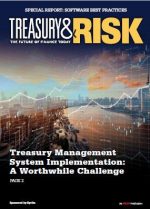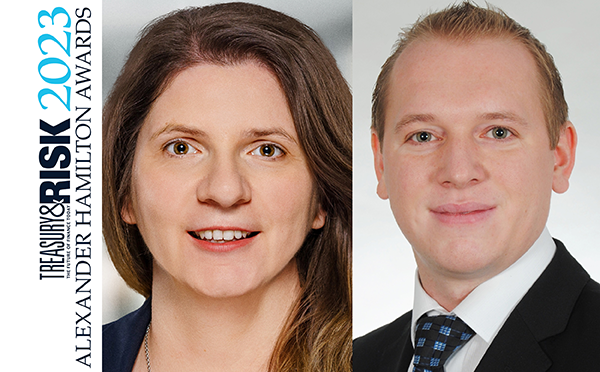Many companies are making treasury management systems apriority this year, and with  good reason. Thesesolutions have the potential to improve cash forecasting, protectcompanies from fraud, and generally boost the efficiency ofcorporate treasury.
good reason. Thesesolutions have the potential to improve cash forecasting, protectcompanies from fraud, and generally boost the efficiency ofcorporate treasury.
But actually implementing them can be more difficult thananticipated, especially for businesses that have never selected orused a treasury workstation. Treasury teams may find that if theydo not plan carefully, they miss opportunities to get the most outof this crucial investment. Proper planning from the higheststrategic levels to the most minute details can go a long waytoward guaranteeing success.
|Damien McMahon, a partner in the Financial & TreasuryManagement practice at PricewaterhouseCoopers, recounts hisexperience of working with clients who rush into implementationwithout considering what they really need from their treasurymanagement system. According to McMahon, sometimes clients finishone part of an implementation only to find themselves out of time,over budget, or just plain overwhelmed.
|“People get a bit exhausted, and then they implement just thebasics with the promise that next year, when everyone hasrecovered, they'll implement all those bells and whistles they weredreaming about in the beginning,” says McMahon. “The only problemis that next year never happens—the next project comes along, andeveryone is busy, and then when priorities shift, there is another[treasury management system] project again three years later.”
|Bob Stark, vice president of strategy for cloud-based treasurymanagement system Kyriba, says companies should engage in carefulplanning and analysis so that they reach consensus on thepriorities and overarching goals of the implementation.
|“It is critical for treasury to know what they need to get outof this, and at a strategic level,” Stark says. “The strategyneeds to be there. If it's not, you get something thatunder-delivers. If you're looking to achieve success, it'simportant that you know exactly what success is.”
|Indeed, Kyriba believes so strongly that strategic planning isvital to the implementation process that the company now has avalue engineering team which specifically helps companies assessand quantify their goals, needs, and priorities, Stark explains.He says this part of the planning work should happen before thecompany gets into the details of what the treasury managementsystem can do or timetables for implementation.
|Adding the value engineering team has been a fairly recent shiftfor the company, Stark adds. “We formalized this process in thepast two years because we recognized that successful projectplanning begins before the company purchases their [treasurymanagement system]. We realized that it was far too easy for atreasury team to focus too much on their existing processes ratherthan thinking about what their end result really should be.”
||
Fitting the Pieces
So, how should a corporate treasury function decide onpriorities? Elaine Filus, principal at consulting firm TreasuryStrategies, says that even before talking to vendors, a treasurydepartment should carefully examine everything it does, every day,and what it might improve. Filus has worked with some clients whotake a week early in a treasury management system project torethink every activity, every control, and every piece ofinformation that feeds into treasury functions, whether it comesfrom another department within the company or from a far-flungbank. The goal of this evaluation is to understand how all thepieces fit together and how they could better work in concert.
|“To the extent that you can think about your operation and whatmight not be particularly efficient now, and what you want to bebetter, the upfront planning can streamline the implementationitself,” Filus says.
|Then companies can prioritize the items on their wishlist.Kyriba's Stark emphasizes that identifying what is most and leastvaluable to the organization goes a long way toward appropriatelyallocating energies and resources. “If you know the value to yourorganization of certain capabilities and certain requirements, ithelps structure the implementation in the right way. You don't getdistracted by other things that just don't deliver the same levelof value.”
|
“Itis critical for treasury to know what they need to get out of [theimplementation], and at a strategic level.”
– Bob Stark, Vice President of Strategy, Kyriba
|
For example, Stark says, when a company realizes the value tobe delivered by a reliable cash forecast, it then can furtheremphasize forecasting in the implementation and prioritize it interms of the amount of resources dedicated to it. When thatpriority is widely understood, every other part of the project plancan map to that priority and fall into its place.
||
Delving into the Details
In addition to a high-level understanding of the overarchinggoals and strategy of a treasury management system implementation,experts agree that it should come with an abiding attention to thedetail required. Indeed, treasury management system implementationsare all about “detail, detail, detail, detail,” says PwC'sMcMahon.
|From this bottom-up perspective, one key best practice is to getthe right people involved from the start, those who can oversee themoving parts and help ensure that no important detail getsignored.
|Forrest Vollrath, executive director of treasury operations atHealth Care Service Corporation (HCSC), advises that companiesthink in terms of three main categories—people, processes, andtechnology— as a framework for the implementation. His company wonan Alexander Hamilton Silver Award in Treasury Transformation in2015, for the enhancement of its cash management and forecastingprocesses through the implementation of a new treasury managementsystem. “This will allow you to better organize the myriad ofchanges involved in the process,” Vollrath says. “The other pieceof advice is to partner with all key stakeholders (upstreamanddownstream) in the planning process.”
|To begin with, usually, a project manager is chosen from thetreasury team and is responsible for project governance. This is akey level of management and oversight that can make all thedifference, says Jeff DiOrio, director, Treasury Strategies.
|“The very best projects we see have very strong governance,”DiOrio says. “If there is strong project management and stronggovernance, it's very clear what people need to get done, and theyknow when it's due, and they also understand what's going to happenif they don't get it done.”
|Most corporate treasury departments assign project managementduties in a treasury management system implementation to someonewithin treasury, says Kyriba's Stark. Aside from the largestorganizations, most corporate treasuries also prefer to workclosely with
|the vendor, rather than waiting for a socalled turnkey solutionthat is delivered ready-for-use, Stark says. “There is no one wayin terms of allocation of internal resources. It depends onavailability, costs, and time required. It's almost like analgebraic equation. But all of these decisions need to be made atthe start so it's agreed upon regarding who is going to deliver allof these milestones and tasks within the project plan.”
|Stark notes that other important people who need to be on boardat the beginning of a treasury management system project are “powerusers,” individuals who will be using the system every day, andsubject matter experts from departments such as accounting,payments, or financial planning and analysis (FP&A). They mayhave an important piece of information to deliver, or may need toweigh in on controls and approvals. Remembering to involve othergroups or teams who use the data, contribute key figures, or areresponsible for signing off on certain thresholds or controls iscritical. “Coordination across functional groups has to be takeninto account,” Stark says.
||
Thinking Realistically
When it comes to planning dates and deliverables, treasury teamsneed to be sure to avoid certain pitfalls, Stark says. The first isresourcing, and the important thing here is to be realistic aboutexpected and unexpected events, like vacations, sick days andsnow days, and even blackout periods. Consider, too, vacationsabroad, which often are three weeks at least, Stark says. “We findespecially with multinationals, if they have a European treasurycenter, scheduling objectives in late July or early August may notbe the best idea. It's understanding the realities.”
|Important, too, are easy-to-overlook communication glitches suchas time zones in Asia, or when bank systems undergo a blackoutperiod that freezes project implementation and testing. These maybe small details, but “being realistic is incredibly important,”Stark says. “In the end it's a key component of a project.”
|Testing is another critical aspect of a treasury managementsystem implementation that companies tend to underestimate at theoutset. “Build in time for testing,” Stark urges.
|And not just one type of testing, says DiOrio of TreasuryStrategies. Make sure testing is rigorous enough to include useracceptance testing, interface testing, and—at the laststage—parallel testing before the old system turns off, he says.“The goal is not testing for testing's sake, it's testing to makesure that when you go live, [the system] functions the way you wantit to,” DiOrio says.
|It could very well be that treasury departments have to rethinkthe timetable for treasury management system implementation aftercarefully considering all aspects of what will be required. It isnot unusual for an implementation to take a full year, or even two,experts point out.
|“Most people underestimate how long it is going to take toimplement a treasury management system,” says McMahon. “That isbecause they haven't gone to the right level of detail.”
||
A Worthwhile Challenge
The good news for treasury departments is that implementing atreasury management system is a challenge which may haveimmeasurable payoff in efficiencies and protections, when donecorrectly. The keys to success are to plan early and well, and tostay focused on the priorities and the carefully crafted projectplan that all relevant parties have agreed to.
|Treasury teams should also work with their chosen vendor to keepthe project focused on their end goal, says Stark. “Especially intreasury, it's easy to get pulled away in a different directionbecause treasury is such a lean organization,” he says. “It'sdifficult to stay focused all the way through a treasury managementsystem implementation, because a lot of times, treasury is in afire drill. That's where good project planning and governance arereally important, so on those really difficult days, you don'tlose time or lose focus. If you plan your implementation properly,and execute it properly, those sorts of things won't happen.”
|Given the need for companies to limit fraud, and the constantpressure to do more with less, this year may well be a banner onefor treasury management system implementations, according to datafrom Treasury Strategies published earlier this year. In January,more corporate treasurers told the consultancy that they weremaking treasury management systems a priority than did so ineither 2017 or 2016.
|
“Theother piece of advice [for a successful implementation] is topartner with all key stakeholders (upstream and downstream) in theplanning process.”
– Forrest Vollrath, Executive Director, Treasury Operation,HCSC
|
Also from this Special Report
|
- SPONSORED STATEMENT: Best Practices in TMS Implementation
Complete your profile to continue reading and get FREE access to Treasury & Risk, part of your ALM digital membership.
Your access to unlimited Treasury & Risk content isn’t changing.
Once you are an ALM digital member, you’ll receive:
- Critical Treasury & Risk information including in-depth analysis of treasury and finance best practices, case studies with corporate innovators, informative newsletters, educational webcasts and videos, and resources from industry leaders.
- Exclusive discounts on ALM and Treasury & Risk events.
- Access to other award-winning ALM websites including PropertyCasualty360.com and Law.com.
*May exclude premium content
Already have an account? Sign In
© 2024 ALM Global, LLC, All Rights Reserved. Request academic re-use from www.copyright.com. All other uses, submit a request to [email protected]. For more information visit Asset & Logo Licensing.








